Dry-Brined Turkey
This post may contain affiliate links. Read my full disclosure policy.
Discover the secret to a perfectly juicy and flavor-packed bird with this easy dry-brined turkey recipe—it’s a holiday game-changer!
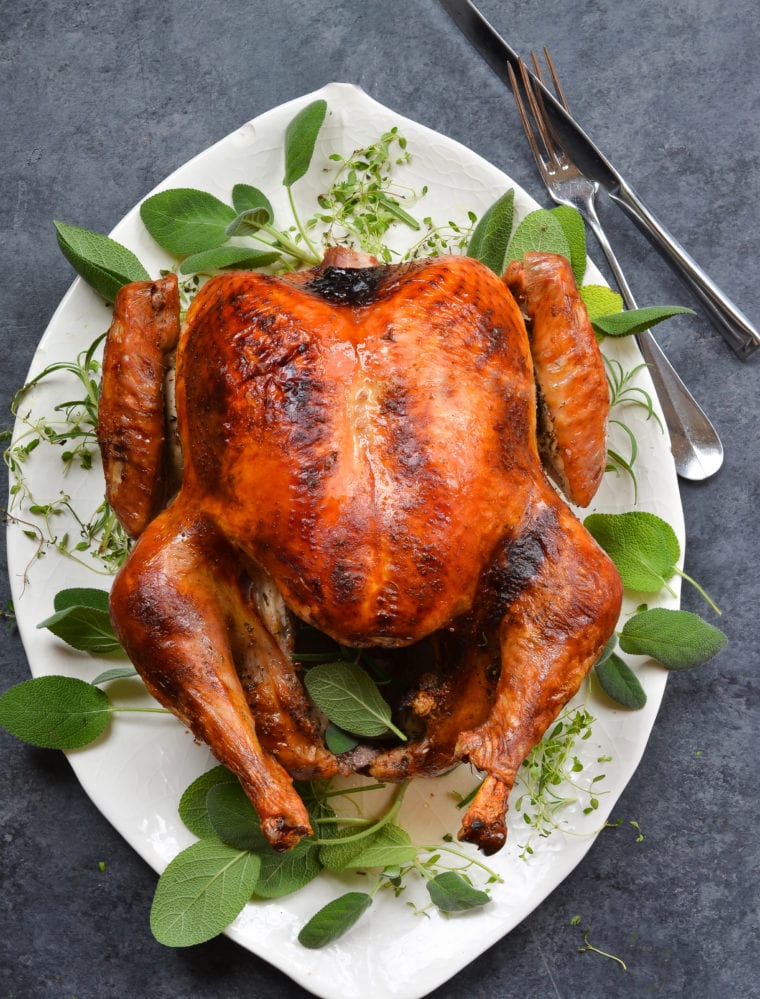
This fantastic dry-brined turkey, adapted from a Jeff Mauro recipe featured in Rachel Ray Magazine, was passed on to me by the talented food stylist Rebecca Jurkevich, who styled my second cookbook. What I particularly love about this recipe is its simplicity. You start by rubbing a mixture of salt and seasonings—the dry brine—onto the turkey’s skin, then let it rest in the fridge overnight. The salt not only thoroughly seasons the meat but also draws out the bird’s natural juices, creating a self-brine that the meat reabsorbs, guaranteeing a turkey that’s flavorful and juicy from the inside out. Plus, the rest in the fridge dries out the exterior of the bird, so when you cook it, you end up with the most beautifully crispy, golden-brown skin. Whether you’re a seasoned cook or a turkey first-timer, this dry-brined turkey recipe is a must-try for its ease and dependable results.
“My husband just declared this is the best turkey we’ve made in 40 years!!!! I concur!!”
What You’ll Need To Make A Dry-Brined Turkey
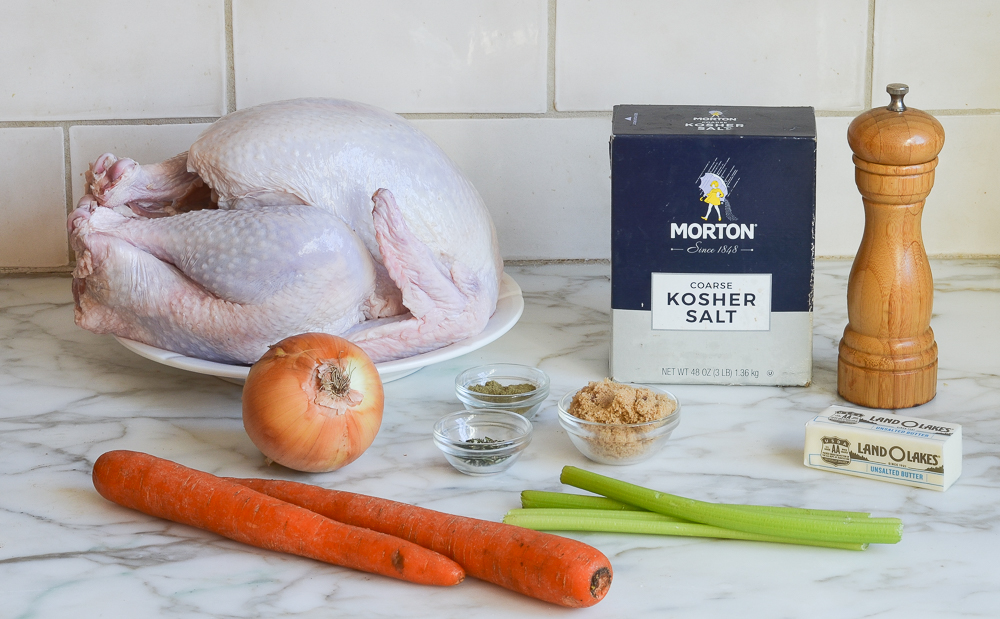
Step-by-Step Instructions
In a small bowl, mix the sugar, salt, thyme, sage, and pepper for the dry brine.
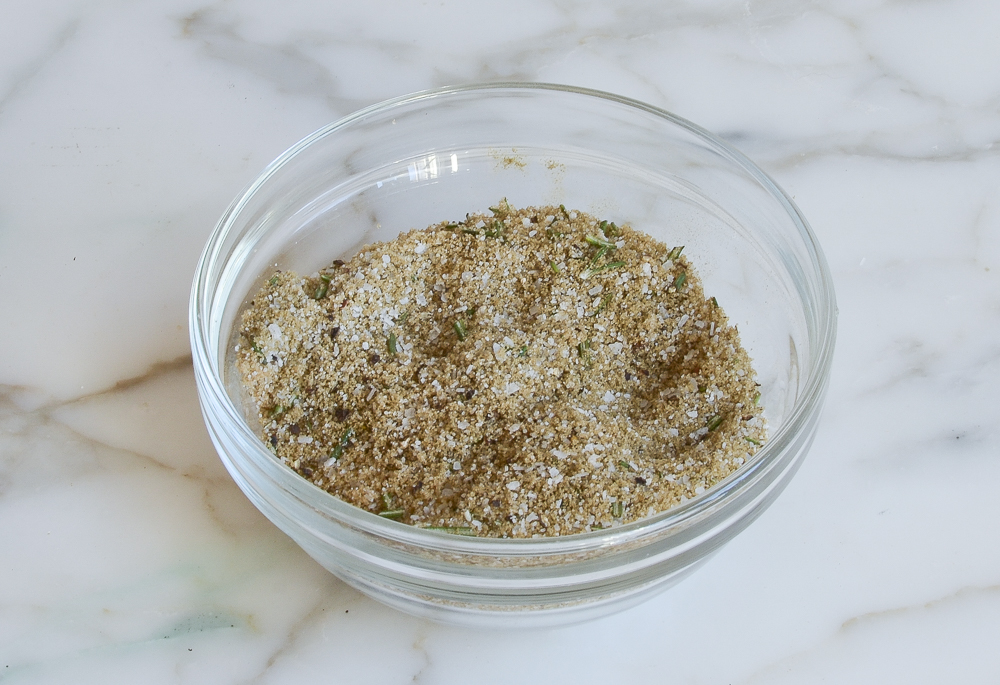
Place the turkey on the rack of a baking sheet. Rub and pat the dry brine all over the turkey, including inside the cavity. Refrigerate, uncovered, for at least 24 hours and up to 48 hours.
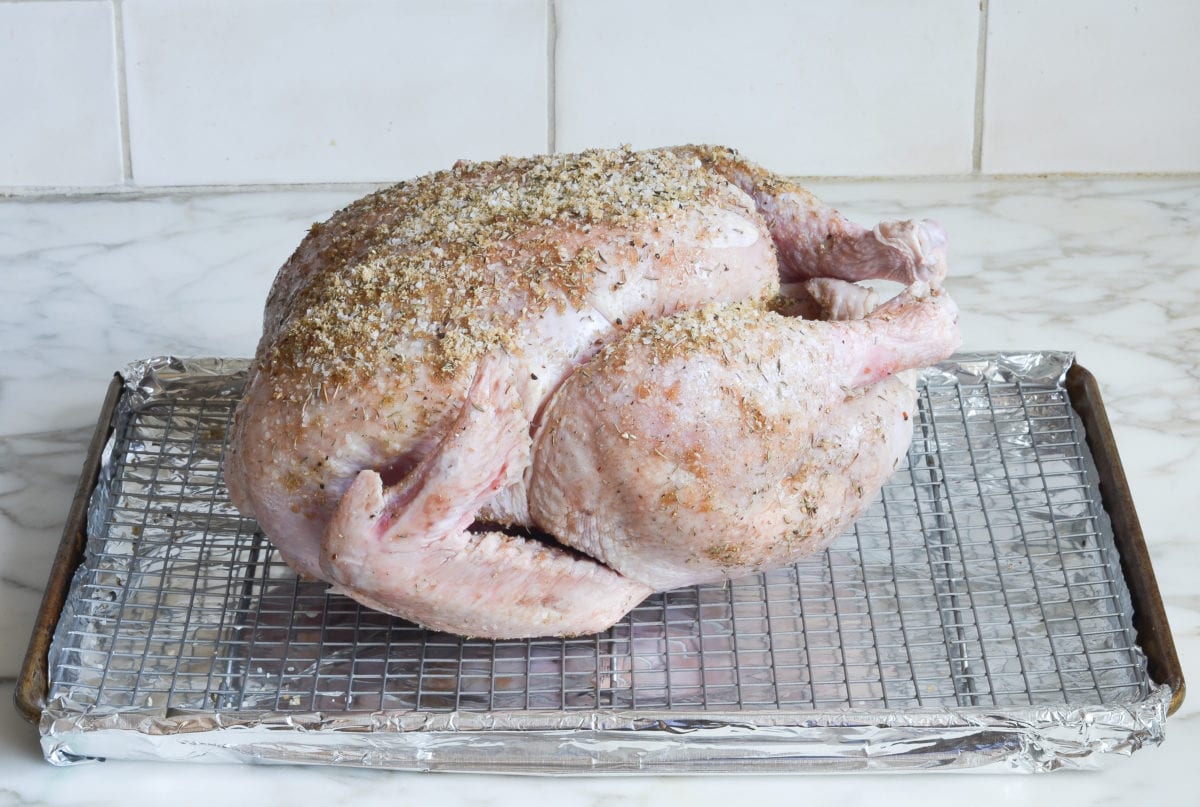
Using damp paper towels, brush the dry brine off the turkey.
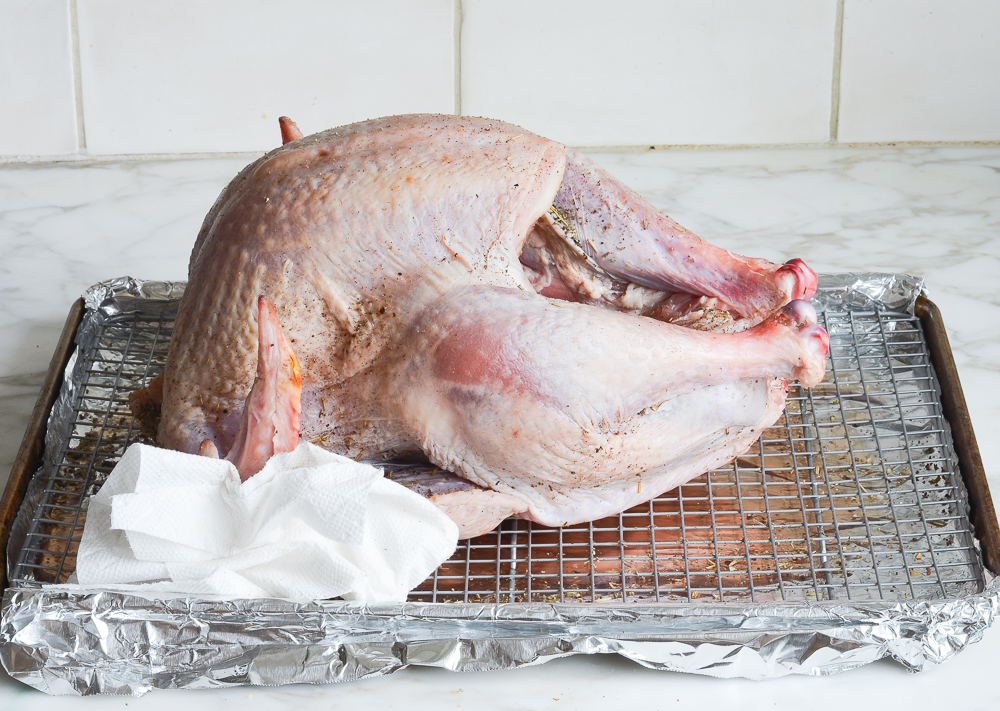
Scatter the onion, carrots, and celery in the bottom of a large roasting pan. Place a roasting rack inside the pan and place the turkey on the rack. Tuck the wings underneath the bird.
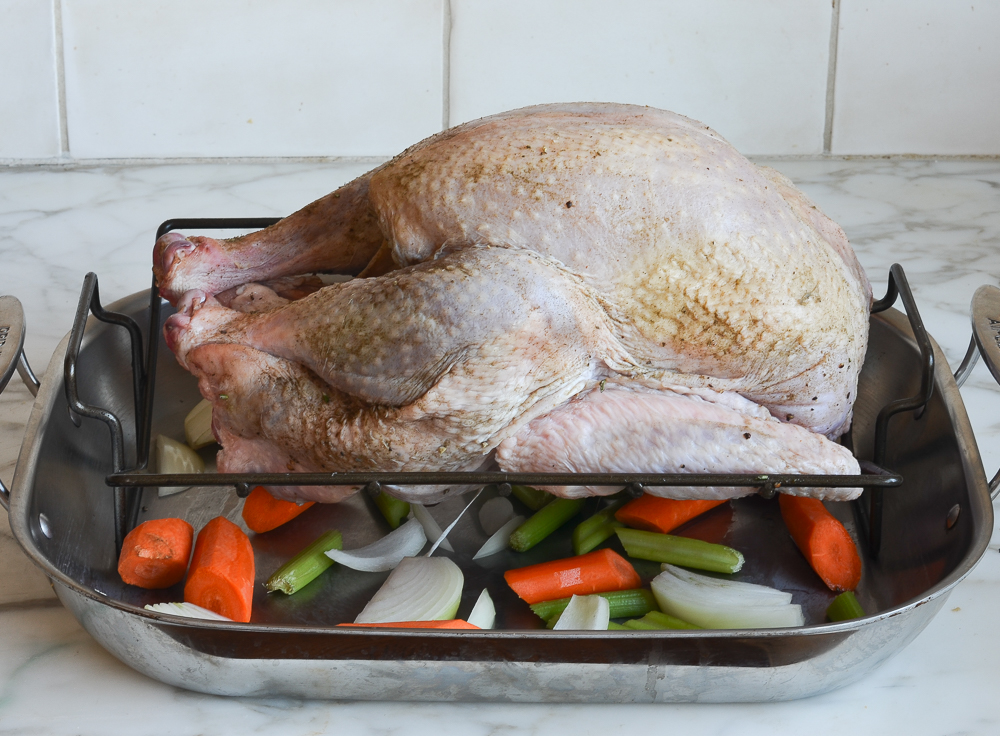
Using your hands, smear the butter all over the turkey.
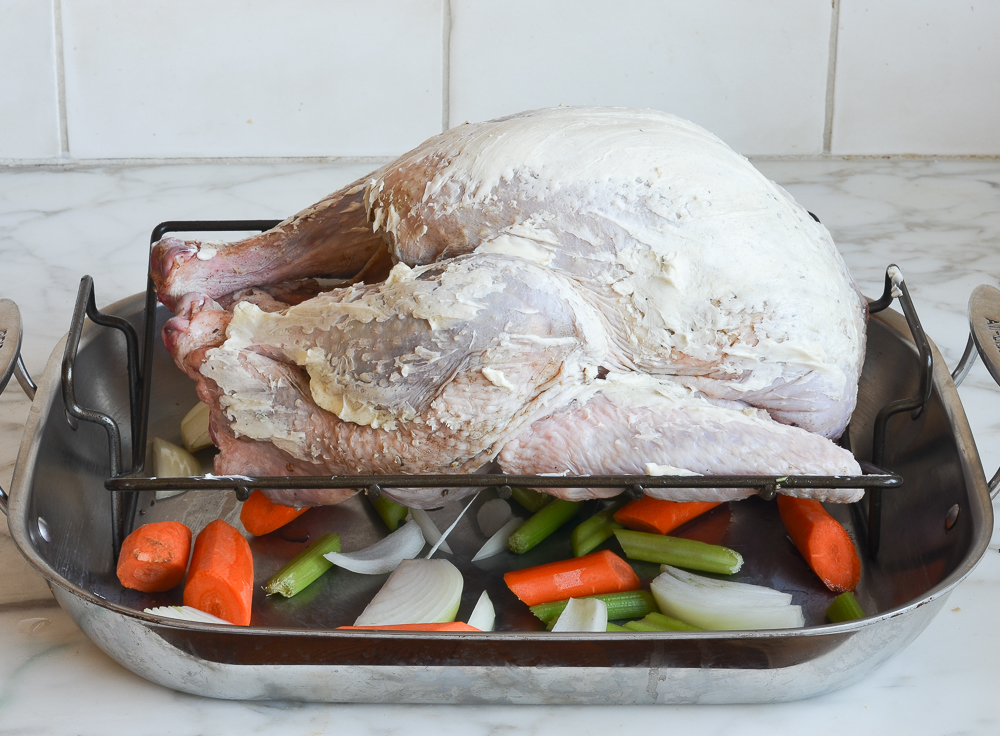
Roast the turkey until the skin is deep golden and an instant-read thermometer registers 165°F when inserted into the thickest part of the breast and the thigh, 1-3/4 to 2-1/2 hours. Check the turkey after 1-1/2 hours. If it’s getting too dark, cover it loosely with foil.
Note: The cooking time will depend on the size of your turkey. For best results, I recommend using a digital thermometer with a leave-in probe and remote monitor, like the one shown below. That way, you can monitor the temperature of the turkey without ever opening your oven.
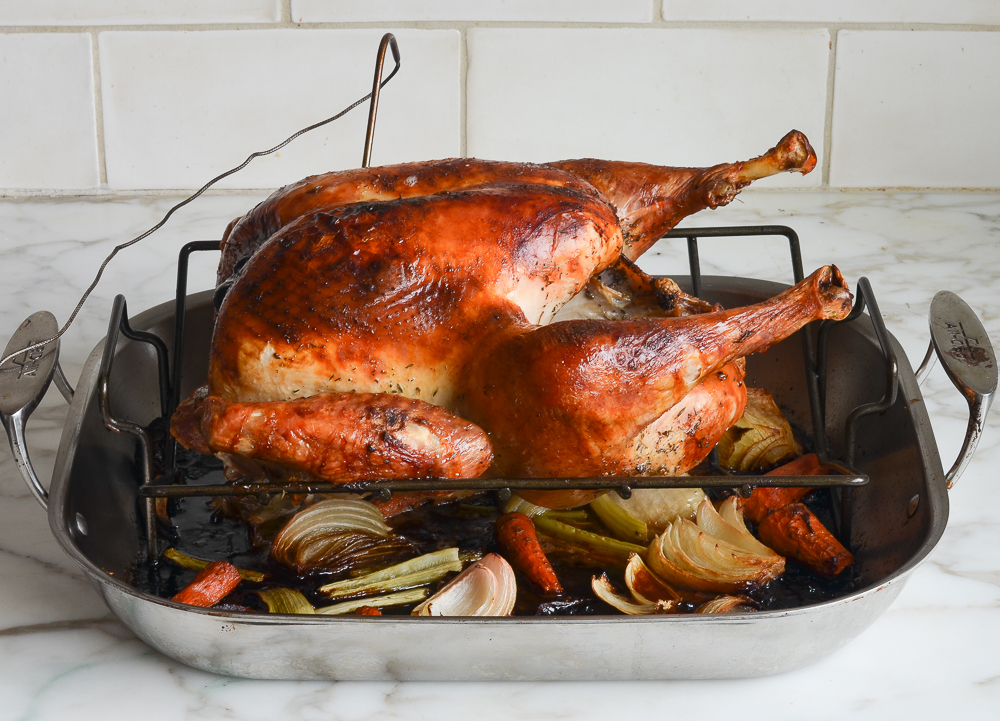
Using clean oven mitts (that you don’t mind getting dirty), carefully tilt the turkey so any juices from the cavity pour into the roasting pan. Transfer the turkey to a platter or cutting board. Tent with foil and let rest for 20 to 30 minutes. Remove the vegetables from the pan and discard (or if they aren’t too soft/brown, save them and arrange on the serving platter with the turkey). Reserve the drippings in the pan for the gravy. While the turkey rests, make the turkey gravy.
Carve the turkey and serve with the gravy on the side.
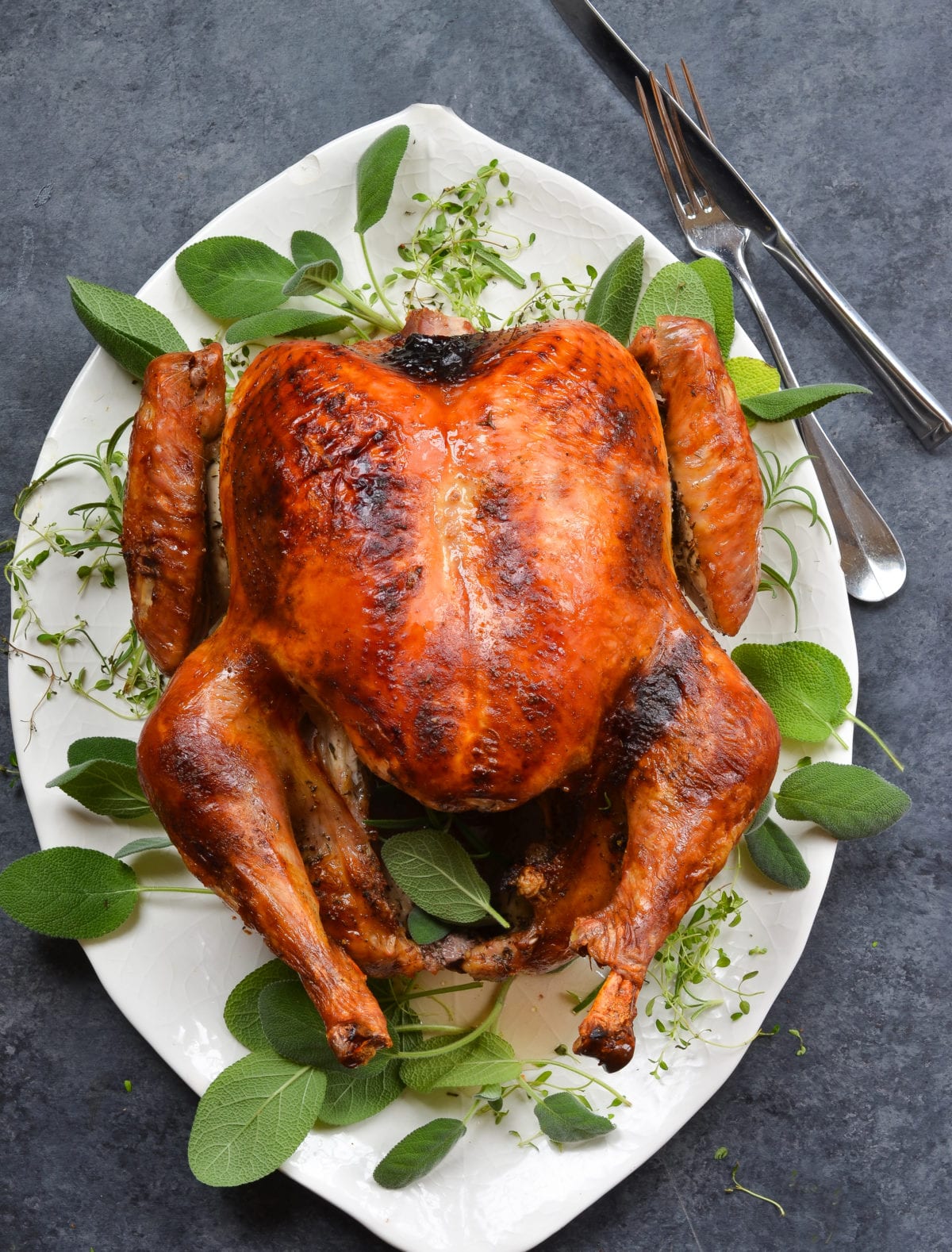
Frequently Asked Questions
A: Dry brining involves rubbing salt, herbs, and spices onto the turkey skin and letting it sit in the fridge overnight (or longer). Wet brining, in contrast, requires soaking the turkey in a seasoned saltwater solution, often necessitating a large cooler or bag and can be quite cumbersome. While both methods enhance flavor and juiciness, dry brining is much simpler and produces crisper skin.
A: The recommended time for dry brining is at least 1 day and up to 3 days. The longer you allow the turkey to brine, the more flavorful and moist it will be. However, even just 24 hours of brining can make a significant difference. You can adjust the salt quantity based on the brining duration to avoid over-salting.
A: If your turkey has been pre-injected with a solution (as is common with many store-bought turkeys), you can still use this dry-brined recipe effectively. These types of turkeys still benefit from additional seasoning for enhanced flavor. However, since they already contain some salt, you should reduce the amount of salt used in the dry brine by half to prevent the turkey from becoming overly salty.
You May Also Like
- 24 Best Thanksgiving Side Dishes
- 18 Thanksgiving Desserts Worth Saving Room For
- Rolled Turkey Breast with Sausage & Herb Stuffing
- Fresh Cranberry Sauce
- Creamy Make-Ahead Mashed Potatoes
- Easy Sausage & Herb Stuffing
Dry-Brined Turkey
Discover the secret to a perfectly juicy and flavor-packed bird with this easy dry-brined turkey recipe—it’s a holiday game-changer!
Ingredients
- 1 (12 to 14-pound) turkey, patted dry (see note)
- ¼ cup (packed) light brown sugar
- 3 tablespoons Morton kosher salt (or ¼ cup Diamond kosher salt)
- 2 teaspoons dried thyme
- 2 teaspoons dried sage leaves or ground sage
- 1 teaspoon freshly ground black pepper
- 6 tablespoons unsalted butter, at room temperature
- 1 large yellow onion, cut into wedges
- 2 carrots, cut into 2-inch pieces
- 2 stalks celery, cut into 2-inch pieces
Instructions
- Line a rimmed baking sheet with aluminum foil for easy clean up, and set an oven rack on top.
- Remove and discard the truss that holds turkey legs together (if the legs are held together with turkey skin, cut the skin to release them). Trim off and discard any excess fat in the neck or body cavity. Remove giblets and neck; discard or save for stock. Rinse the turkey inside and out with warm water. Pat dry with paper towels.
- In a small bowl, mix the sugar, salt, thyme, sage, and pepper for the dry brine. Place the turkey on the rack of the prepared baking sheet. Rub and pat the dry brine all over the turkey, including inside the cavity. Refrigerate, uncovered, for at least 24 hours and up to 48 hours. (For food safety, ensure the turkey remains in the refrigerator at 40°F or lower during the entire brining period. If brining for longer than 24 hours, you can cover the turkey loosely with plastic wrap for the first part of the brining process and then uncover it for the final 24 hours to allow the skin to dry.)
- Preheat the oven to 375°F and set an oven rack in the lower third of the oven. Using damp paper towels, brush the dry brine off the turkey.
- Scatter the onion, carrots, and celery in the bottom of a large roasting pan. Place a roasting rack inside the pan and place the turkey on the rack. Tuck the wings underneath the bird. Using your hands, smear the butter all over the turkey.
- Roast the turkey until the skin is deep golden and a leave-in or instant-read thermometer registers 165°F when inserted into the thickest part of the breast and the thigh, 1¾ to 2½ hours (see note). Check the turkey after 1½ hours. If the skin is getting too browned, cover it loosely with foil.
- Using clean oven mitts (that you don't mind getting dirty), carefully tilt the turkey so any juices from the cavity pour into the roasting pan. Transfer the turkey to a platter or cutting board. Tent with foil and let rest for 20 to 30 minutes. Remove the vegetables from the pan and discard (or if they aren't too soft/brown, save them and arrange on the serving platter with the turkey). Reserve the drippings in the pan for the gravy.
- While the turkey rests, make the gravy.
- Carve the turkey and serve with the gravy on the side.
- Make-Ahead Instructions: If you don't mind losing the crispy skin, the turkey can be roasted and carved ahead of time. Pour a thin layer of the gravy into an ovenproof serving dish. Arrange the carved turkey nicely on top of the gravy; cover tightly with plastic wrap and refrigerate for up to two days. Refrigerate the remaining gravy in a separate container. To reheat: remove the plastic wrap and cover the platter with aluminum foil. Place in a 325°F-oven for 20 to 30 minutes, until the turkey is hot. Reheat the gravy in the microwave or on the stovetop.
- Note on Selecting Your Turkey: For the best results with this dry-brining method, look for a turkey that is not kosher, injected, or labeled as "self-basting." These types of turkeys have already been treated with salt or a brining solution. However, if you can only find a kosher, injected, or self-basting turkey, you can still use this recipe, as these birds do still benefit from additional seasoning. Just halve the amount of salt in the dry brine to avoid over-salting.
- Note: I've given a range for the cooking time, which will depend on the size of your turkey. For best results, I recommend using a digital thermometer with a leave-in probe and remote monitor (like this one). That way, you can monitor the temperature of the turkey without ever opening your oven.
Pair with
Nutrition Information
Powered by ![]()
- Per serving (8 servings)
- Calories: 1,075
- Fat: 47 g
- Saturated fat: 15 g
- Carbohydrates: 6 g
- Sugar: 5 g
- Fiber: 0 g
- Protein: 147 g
- Sodium: 1,619 mg
- Cholesterol: 513 mg
This website is written and produced for informational purposes only. I am not a certified nutritionist and the nutritional data on this site has not been evaluated or approved by a nutritionist or the Food and Drug Administration. Nutritional information is offered as a courtesy and should not be construed as a guarantee. The data is calculated through an online nutritional calculator, Edamam.com. Although I do my best to provide accurate nutritional information, these figures should be considered estimates only. Varying factors such as product types or brands purchased, natural fluctuations in fresh produce, and the way ingredients are processed change the effective nutritional information in any given recipe. Furthermore, different online calculators provide different results depending on their own nutrition fact sources and algorithms. To obtain the most accurate nutritional information in a given recipe, you should calculate the nutritional information with the actual ingredients used in your recipe, using your preferred nutrition calculator.
Gluten-Free Adaptable Note
To the best of my knowledge, all of the ingredients used in this recipe are gluten-free or widely available in gluten-free versions. There is hidden gluten in many foods; if you're following a gluten-free diet or cooking for someone with gluten allergies, always read the labels of your ingredients to verify that they are gluten-free.

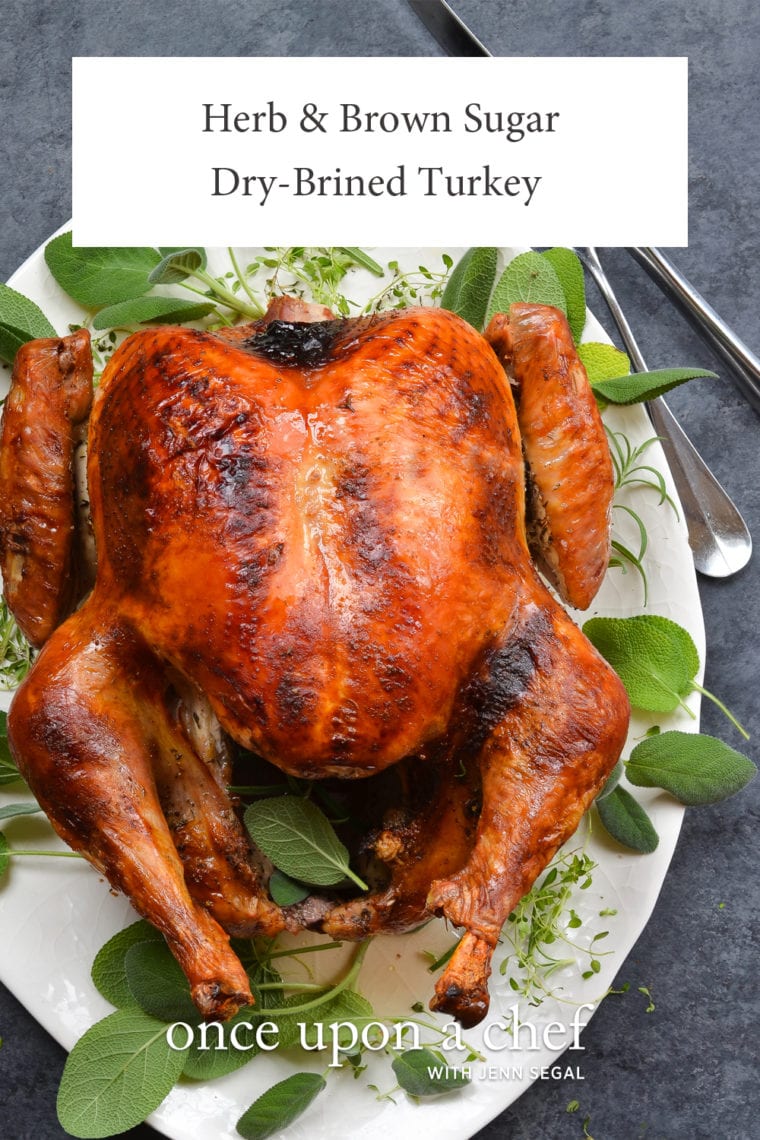
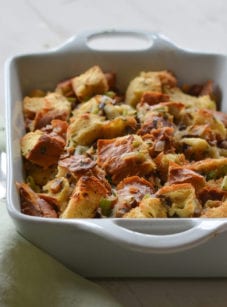
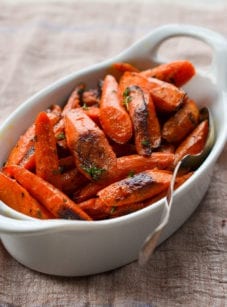
Hi! What temp do you cook the turkey? I don’t see it in the recipe. Thank you!!
Hi Robyn, The turkey gets cooked at 375°F. Hope you enjoy!
Hi Jenn,
I love all your recipes!! In previous years, I have always used Alton Brown’s turkey recipe but I HATE the smoke in the kitchen for hours despite a clean oven,…and, not a fan of wet brining. So, this recipe sounds amazing and I would like to try it this Thanksgiving!! What is the temperature I should cook a 14/16 pound turkey? I didn’t recall seeing a temp setting in the recipe.
Thanks!!
Hi Robyn, So glad you like the recipes! The turkey should be roasted at 375°F. Hope you enjoy!
I am wondering about thawing. Should I thaw all the way and then dry brine for a day? I’ve got a 20 pounder in the freezer that will likely take 5 days thaw. Thanks
Hi Susan, I think you could brine the turkey toward the tail end of thawing. Hope you enjoy!
Just to confirm, I don’t rinse off the dry brine with water, I just wipe it off with a towel?
Excited to try this! ( and I LOVE you new cookbook!)
Correct (the paper towels should be a little damp though). So glad you like the cookbook! 🙂
I have a convection oven, I always have a hard time adjusting the cooking temperature so The turkey remains juicy and doesn’t cook too fast. Should your cooking time and/or oven temp be adjusted for a Viking convection oven? Thank you
Hi Lisa, Yes I would reduce the temp by 25°F. The cooking time should be the same.
Can I use a cooking bag with the dry brine?
Hi Shirl, I don’t recommend it if you want crispy skin.
I always do a wet brine, but after reading the reviews I want to give this dry brine a try. If I do the dry brine can I still bake my turkey the way I always have? I soak a cheesecloth in butter and white wine and place that on top of the turkey for a period of time. The first 30 minutes I set my oven to 450, then turn it down to 350 and baste every 30 minutes with remaining white wine. Thank you
Hi Mary, Yes you could do that but the skin will not crisp up as nicely.
Thank you, and you did say we it was okay to stuff the turkey?
Yes, it’s fine to stuff the turkey. Enjoy!
Delicious, I followed this recipe as written, I brined the Turkey in the refrigerator for 48 hours and cooked the 12 1/2 lb turkey for 1hr and forty-five minutes, any longer I believe that it would have come out dry. The turkey was juicy had crisp skin and was delicious, will be have this again and again.
This is the turkey we made last year and it’s the best thanksgiving turkey we’ve ever had! The skin was so crispy + the meat was so moist. Back here again to prep for thanksgiving this year! We don’t want to try another kind of turkey now 🙂
We really enjoy stuffing that’s been baked inside the turkey. I normally prepare the stuffing the day before and then bring it to room temperature before putting it in the turkey so that both the turkey and the stuffing will come to a safe temperature at about the same time.What are your thoughts for using this turkey recipe with stuffing in the bird? …especially since you recommend putting the rub inside the cavity as well.
Hi Linda, I really prefer stuffing baked outside of the turkey as it gets a lot more crispy. That said, if you want to bake the stuffing in the turkey, it should be fine here. The rub on the inside of the turkey may slightly alter the flavor of the stuffing but it should still be good. Hope you enjoy!
Hi Jenn!! Just wondering if you think stuffing the bird will add significant time to cooking! We have a 15-lb bird and are going to use your recipe (bird’s already brined!) at the request of my family who loves everything of yours we make! Should we plan to cook longer at 375 if stuffing? Thank you and Happy Thanksgiving!
Hi Taylor, Yes it will definitely take longer. For a stuffed 15-lb bird, I would reduce the temperature to 325 and cook for a little over 4 hours (check for doneness with a thermometer to be sure). Hope that helps and please LMK how it turns out!
Jenn, Can I still stuff the turkey using this method. We enjoy our stuffing “inside” the bird. Thanks!
Hi Connie, that will work here.